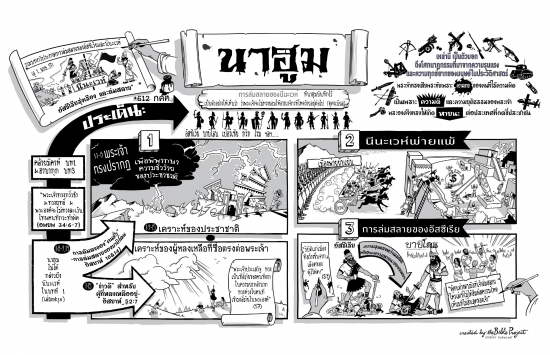องค์พระเจ้าทรงแสนประเสริฐ
เป็นที่ลี้ภัยในยามยากลำบาก
ถอดความจาก นาฮูม 1:7
บทสรุปย่อ นาฮูม
เพื่อให้เพื่อน ๆ ได้อ่านพระคัมภีร์โดยมองเห็นภาพรวมโดยฟังจากดร.ทิม แมคกี
พร้อมกับดูโปสเตอร์ จะเข้าใจความหมายได้อย่างสมบูรณ์ ดูยูทูบที่
เนื่องจากไม่มีซับไตเติ้ลภาษาไทย โปรดดูคำแปลข้างล่าง
บทสรุปที่เป็นโปสเตอร์นี้ เราได้รับอนุญาตการแปลจาก ไบเบิลโปรเจกต์
โดยสามารถนำไปใช้เพื่อการศึกษาในคริสตจักร กลุ่มเซลต่าง ๆ ในชั้นเรียนรวีฯ
หรือการเรียนพระคัมภีร์ส่วนตัวได้โดยไม่ให้ใช้เพื่อการค้า
ขอบคุณสำหรับฟอนต์ไทยจาก ฟอนต์.คอม
ต่อไปเป็นข้อความอธิบายสคริปต์ของนาฮูม ต้องขออภัยที่ไม่สามารถใส่คำไทยลงไปในตัวคลิปยูทูป เนื่องจากทางยูทูปเองไม่อนุญาตให้ทำเช่นนั้นแล้ว
| 0:02 | The book of the prophet Nahum | หนังสือของผู้เผยพระคำ นาฮูม |
| 0:06 | This short prophetic book is a collection of poems announcing the downfall of one | หนังสือคำพยากรณ์เล่มสั้น ๆ นี้ เป็นการรวบรวมบทกวีประกาศการล่มสลายของ |
| 0:10 | of Israel’s worst oppressors, the ancient empire of Assyria and its capital city Nineveh. | หนึ่งในศัตรูตัวร้ายของอิสราเอล จักรวรรดิอัสซีเรียโบราณ และเมืองหลวงคือนีนะเวห์ |
| 0:16 | The Assyrians arose as one of the world’s first great empires. | อัสซีเรียรุ่งเรืองขึ้น เป็นหนึ่งในจักรวรรดิแรกๆ ที่ยิ่งใหญ่ |
| 0:19 | And their expansion into Israel resulted in the total destruction and exile of the | การขยายอาณาเขตเข้าไปในอิสราเอล ทำให้อิสราเอลล่มสลาย เกิดการกวาด |
| 0:24 | northern kingdom and its tribes. | คนจากอาณาจักรเหนือและเผ่าต่าง ๆ ไปเป็นเชลย |
| 0:26 | The Assyrian armies were violent and destructive on a scale that the world had never seen before. | กองทัพอัสซีเรียโหดร้ายรุนแรงและก่อให้เกิดความหายนะที่โลกไม่เคยเห็นมาก่อน |
| 0:31 | And so Israel and its neighbors were awaiting the downfall of Assyria, | ดังนั้น อิสราเอลและประเทศเพื่อนบ้านจึงรอคอยการล่มสลายของอัสซีเรีย |
| 0:35 | which eventually came in the year 612 BC. | ซึ่งในที่สุด ก็เกิดขึ้นก่อนคริสตศักราช 612 ปี |
| 0:38 | The Babylonians rose up and began a rebellion that overtook Nineveh | บาบิโลนเริ่มได้อำนาจและก่อการกบฏ ในที่สุดก็ชนะนีนะเวห์ |
| 0:42 | and brought down the Assyrian Empire. | และทำลายจักรวรรดิอัสซีเรีย |
| 0:44 | And so chapter 2 depicts the fall of Nineveh in vivid poetry. | บทที่สองได้บรรยายถึงการแตกของกรุงนีนะเวห์อย่างชัดเจน |
| 0:48 | And chapter 3 then explores the downfall of the empire as a whole. | บทที่สามได้สืบค้นดูการล่มสลายของจักรวรรดิโดยรวม |
| 0:52 | But, this book isn’t just an angry tirade against Israel’s enemies. | แต่หนังสือนี้ ไม่ใช่เป็นหนังสือประณามศัตรูของอิสราเอลเท่านั้น |
| 0:57 | The introductory chapter shows us that there is way, way more going on here. | บทแรกได้บอกเราว่า มีอย่างอื่นมากกว่านั้น |
| 1:01 | The book opens with an incomplete alphabet poem that begin by describing | หนังสือเริ่มต้นด้วยบทกวีที่เริ่มด้วยพยัญชนะต่อเนื่องอย่างไม่สมบูรณ์ อธิบาย |
| 1:06 | a powerful appearance of God’s glory. | การปรากฏของพระสิริของพระเจ้าที่เต็มด้วยฤทธิ์อำนาจ |
| 1:08 | It’s very similar to how the previous book, Micah, begin and how the next book, Habakkuk, is going to conclude. | คล้ายคลึงกับหนังสือเล่มก่อนคือมีคาห์ และหนังสือเล่มต่อไปคือฮาบากุกก็จะสรุปให้ |
| 1:15 | And it’s God, the all-powerful Creator, coming to confront the nations and bring His justice on their evil. | และพระเจ้าผู้สร้างผู้ทรงอำนาจสูงสุด เสด็จมาประจัญกับประเทศต่าง ๆ ทรงนำการพิพากษาลงโทษมาเหนือความชั่วของพวกเขา |
| 1:21 | And the poem opens by quoting from the famous line of God’s self-description | บทกวีเปิดโดยอ้างถึง การที่พระเจ้าทรงอธิบายพระลักษณะของพระองค์เอง |
| 1:26 | after the golden calf incident, in the book of Exodus chapter 34, | หลังจากเหตุการณ์วัวทองคำในหนังสืออพยพบทที่ 34 |
| 1:29 | “The Lord is slow to anger, He’s great in power, He won’t leave evil unpunished.” | “พระเจ้าทรงกริ้วช้า ทรงฤทธานุภาพยิ่งใหญ่ พระองค์จะไม่ปล่อยให้คนผิดลอยนวล” |
| 1:35 | And so the rest of the poem goes back and forth, | บทกวีตอนต่อมา ก็จะกลับไปกลับมา |
| 1:37 | contrasting the fate of the arrogant violent nations with the fate of God’s faithful remnant. | ให้เราเห็นเคราะห์กรรมของประเทศที่รุนแรง กับอนาคตของผู้หลงเหลือที่ซื่อตรงต่อพระเจ้า |
| 1:43 | When God brings down all the arrogant empires, | เมื่อพระเจ้าทรงนำจักรวรรดิที่ยโสให้ล้มลง |
| 1:46 | He will provide refuge for those who humble themselves before Him. | พระองค์จะประทานที่ลี้ภัยให้กับคนที่ถ่อมตนต่อพระองค์ |
| 1:49 | Now here’s what’s really interesting. | ตรงนี้ น่าสนใจมาก |
| 1:51 | Is that you thought this book was only about Assyria | คุณคิดว่า หนังสือนี้กล่าวถึงอัสซีเรียเท่านั้น |
| 1:55 | but Nahum actually nowhere mentions Nineveh or Assyria in chapter 1. | แต่นาฮูม กลับไม่ได้กล่าวถึงนีนะเวห์ หรืออัสซีเรียในบทที่หนึ่งเลย |
| 1:59 | And when he describes the downfall of the bad guys, | และเมื่อเขาพรรณาถึงการล่มสลายของผู้ร้าย |
| 2:02 | he uses Isaiah’s language about the fall of Babylon | เขาก็ใช้ภาษาของอิสยาห์ที่กล่าวถึงการล่มสลายของบาบิโลน |
| 2:06 | (which happened much later in history). | (ซึ่งเกิดขึ้นจริงหลังจากนั้นนานมาก) |
| 2:08 | And not only that, Nahum also describes the downfall of the bad guys | ไม่แต่เพียงเท่านั้น นาฮูมยังอธิบายถึงจุดจบของคนร้าย |
| 2:12 | as good news for the remnant of God’s people. | ในฐานะที่เป็นข่าวดีของคนที่หลงเหลือของพระเจ้า |
| 2:15 | It’s a direct allusion to Isaiah’s good news about the downfall of Babylon. | เป็นการกล่าวถึงข่าวดีของอิสยาห์ตรงๆ เรื่องการล่มสลายของบาบิโลน |
| 2:19 | And so all these little details from Chapter 1, they come together to make a key point: | และรายละเอียดเล็กๆ จากบทที่หนึ่ง ก็เข้ามารวมกันเป็นประเด็นหลัก |
| 2:23 | for Nahum, the fall of Nineveh is being presented as an example. | สำหรับนาฮูม การล่มสลายของนีนะเวห์ถือเป็นตัวอย่าง |
| 2:28 | As an image of how God is at work in history in every age. | เป็นภาพของการที่พระเจ้าทรงทำการของพระองค์ในทุกยุคทุกสมัย |
| 2:32 | How He won’t allow the arrogant or violent empires of our world to endure forever. | พระองค์จะไม่ทรงปล่อยให้ความยโส หรือความรุนแรงของโลกยั่งยืนตลอดไป |
| 2:38 | So the message of Nahum is actually very similar to that of Daniel. | ข่าวสารของนาฮูมนั้นคล้ายคลึงกับดาเนียล |
| 2:41 | Assyria stands in a long line of violent empires throughout history. | อัสซีเรีย เป็นจักรวรรดิที่ใช้ความรุนแรงมาตลอดในประวัติศาสตร์ |
| 2:46 | And Nineveh’s fate is a memorial to God’s commitment to bring down the violent and the arrogant in every age. | ชะตากรรมของนีนะเวห์เป็นเครื่องเตือนให้รู้ว่า พระเจ้าทรงมุ่งที่จะทำลายผู้ที่รุนแรงและยโสในทุกสมัย |
| 2:54 | With this perspective from the opening chapter, | ด้วยมุมมองดังกล่าวจากบทแรก |
| 2:56 | the book then returns to its focus on Assyria. | หนังสือก็กลับมาสนใจที่อัสซีเรีย |
| 2:58 | And so chapter 2 describes the Battle of Nineveh and the overthrow of the city in progressive stages. | บทที่สองบรรยายถึงศึกของนีนะเวห์ และขั้นตอน ภาพของการที่เมืองถูกทำลาย |
| 3:03 | So first, we see the front line of Babylonian soldiers. | อย่างแรก เราเห็นทัพหน้าของบาบิโลน |
| 3:07 | And then we read about the charge of the chariots. | แล้วเราก็ได้อ่านเรื่องการจู่โจมโดยรถม้า |
| 3:09 | And then the chaos on the city walls as the city is breached. | ความวุ่นวายปั่นป่วนที่กำแพงเมืองขณะที่เมืองกำลังจะแตก |
| 3:12 | Then the slaughter of Nineveh’s people. Then the plundering of the city. | ต่อมาเป็นการสังหารหมู่ชาวเมืองนีนะเวาห์ ตามด้วยการปล้นสะดมเมือง |
| 3:16 | Chapter 3 goes on to describe the results of the city’s downfall for the empire as a whole. | บทที่สาม ได้เล่าถึงผลของการล่มสลายของเมือง ซึ่งหมายถึงการล่มของจักรวรรดิอัสซีเรียด้วย |
| 3:21 | So Nahum begins by announcing a woe upon the city | นาฮูมเริ่มด้วยการประกาศวิบัติเหนือเมือง |
| 3:25 | whose kings built it with the blood of the innocent. | เมืองที่กษัตริย์สร้างขึ้นมาจากเลือดเนื้อของคนที่ไร้ความผิด |
| 3:28 | It’s an image of how injustice was built into the very system that made Assyria so successful. | เป็นภาพของการที่ความ อยุติธรรมที่ฝังรากในระบบการปกครองที่ทำให้อัสซีเรียรุ่งเรือง |
| ติ3:34 | But their violence has sown the seeds of their own destruction, and so Assyria will fall before Babylon. | แต่ความรุนแรงนี้เอง เป็นตัวหว่านความหายนะของพวกเขา และทำให้อัสซีเรียล่มสลายก่อนบาบิโลน |
| 3:40 | The book concludes with a taunt against the fallen king of Assyria. | หนังสือสรุปด้วยการเย้ยหยันกษัตริย์อัสซีเรียที่หมดอำนาจ |
| 3:44 | He’s stricken with a fatal wound. | ท่านมีบาดแผลฉกรรจ์ถึงตาย |
| 3:46 | And from among all the nations, that he once oppressed, no one comes to help him. | ไม่มีใครจากประเทศต่างๆ ที่กษัตริย์องค์นี้เคยกดขี่ เข้ามาช่วยเลย |
| 3:51 | Rather they sing and celebrate his destruction. | ทุกคนต่างร้องเพลงฉลองที่เห็นหายนะของพระองค์ |
| 3:55 | And that’s how the book ends. | หนังสือจบลงอย่างนี้ |
| 3:58 | Now this is a gloomy book. | นี่เป็นหนังสือที่หดหู่.. |
| 4:00 | But it’s important to see how Nahum’s message addresses | แต่สิ่งที่สำคัญคือ ว่านาฮูมได้เน้น |
| 4:03 | the tragic and perpetual cycles of human violence and oppression in every age. | ความโศกสลด และวัฏจักรของความรุนแรงและการกดขี่ของมนุษย์ในทุกยุคทุกสมัย |
| 4:08 | Human history is filled with tribes and nations elevating themselves | ประวัติศาสตร์โลกนี้เต็มด้วยการที่ชนเผ่าและประเทศต่าง ๆ พยายามยกฐานะของตนเอง |
| 4:13 | and using violence to take what they want, resulting in the death of the innocent. | โดยใช้ความรุนแรงเพื่อขู่เข็ญเอาสิ่งที่ตนต้องการ ส่งผลให้คนไร้ผิดต้องตาย |
| 4:18 | And the book of Nahum uses Assyria and Babylon as examples | หนังสือนาฮูมใช้อัสซีเรียและบาบิโลนเป็นตัวอย่าง |
| 4:21 | to tell us that God is grieved. | เพื่อบอกเราว่า พระเจ้าทรงเสียพระทัย |
| 4:24 | And that He cares about the death of the innocent. | พระองค์ทรงห่วงใยความตายของคนไร้ผิด |
| 4:26 | And that His goodness and His justice compel Him to orchestrate the downfall of oppressive nations. | และความดีและความยุติธรรมของพระเจ้า บังคับให้พระองค์จัดการกับประเทศที่กดขี่ข่มเหงประชาชน |
| 4:32 | And God’s judgment on evil is good news. | การที่พระเจ้าทรงพิพากษาความชั่วนั้น เป็นข่าวดี |
| 4:35 | Unless, of course, you happen to be Assyria. | ยกเว้นแต่ว่า คุณเป็นอัสซีเรีย |
| 4:38 | Which brings us all the way back to the conclusion of that opening poem in chapter 1. | ซึ่งนำเรากลับไปสู่ข้อสรุปจากบทกวีในบทที่หนึ่ง |
| 4:42 | Which tells us that, | บทกวีบอกเราว่า |
| 4:43 | “The Lord is good and a refuge in the day of distress. He cares for those who take refuge in Him.” | พระผู้เป็นเจ้าทรงประเสริฐ และทรงเป็นที่ลี้ภัยในวันยากลำบาก พระองค์ทรงห่วงใยคนที่ลี้ภัยในพระองค์ |
| 4:50 | And so the little book of Nahum invites every reader | หนังสือนาฮูมเล่มสั้น ๆ นี้ ชวนให้ท่านผู้อ่านทุกคน |
| 4:53 | to humble themselves before God’s justice. | ได้ถ่อมตนลงต่อความยุติธรรมของพระเจ้า |
| 4:56 | And to trust that, in His time, He will bring down the oppressors of every time and place. | และเชื่อว่า ในเวลาของพระองค์ พระองค์จะทรงจัดการกับผู้กดขี่ไม่ว่าในยุคสมัยใด ที่ใด |
| 5:02 | And that’s what the book of Nahum is all about. | และนี่คือเนื้อหาของหนังสือนาฮูม |

